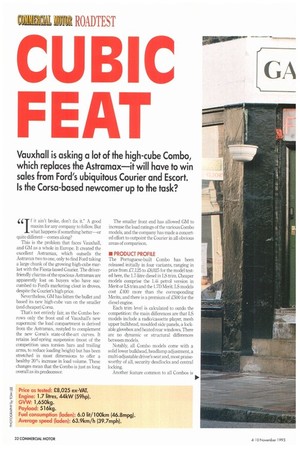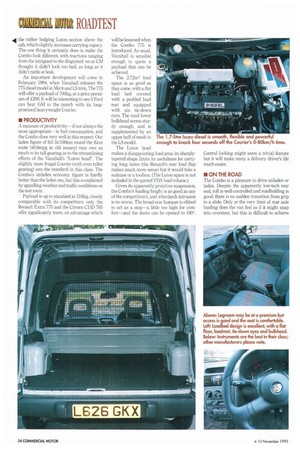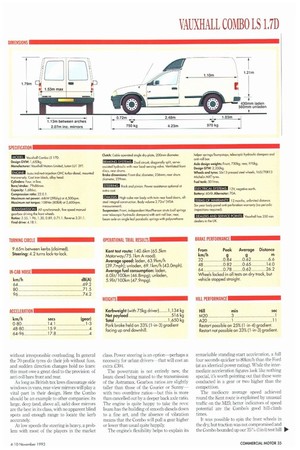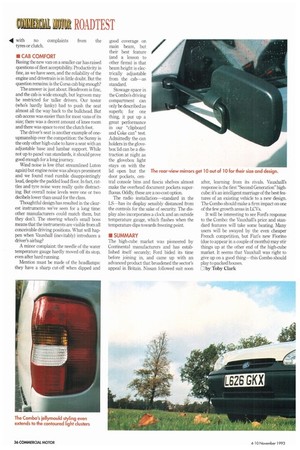Vauxhall is asking a lot of the high-cube Combo, which
Page 34

Page 36

Page 37

Page 38

If you've noticed an error in this article please click here to report it so we can fix it.
replaces the Astramax—it will have to win sales from Ford's ubiquitous Courier and Escort. Is the Corsa-based newcomer up to the task?
/
( ( f it ain't broke, don't fix it." A good maxim for any company to follow. But what happens if something better—or quite different—comes along?
This is the problem that faces Vauxhall, and GM as a whole in Europe. It created the excellent Astramax, which outsells the Astravan two to one, only to find Ford taking a large chunk of the growing high-cube market with the Fiesta-based Courier. The driver. friendly charms of the spacious Astramax are apparently lost on buyers who have succumbed to Ford's marketing clout in droves, despite the Courier's high price.
Nevertheless, GM has bitten the bullet and based its new high-cube van on the smaller (and cheaper) C,orsa.
That's not entirely fair, as the Combo borrows only the front end of Vauxhall's new supermini: the load compartment is derived from the Astramax, restyled to complement the new Corsa's state-of-the-art curves. It retains leaf-spring suspension (most of the competition uses torsion bars and trailing arms, to reduce loading height) but has been stretched in most dimensions to offer a healthy 20% increase in load volume. These changes mean that the Combo is just as long overall as its predecessor. The smaller front end has allowed GM to increase the load ratings of the various Combo models, and the company has made a concerted effort to outpoint the Courier in all obvious areas of comparison,
II PRODUCT PROFILE
The Portuguese-built Combo has been released initially in four variants, ranging in price from £7,125 to £8,025 for the model tested here, the 1.7-litre diesel in LS trim. Cheaper models comprise the 1.4i petrol version in Merit or LS trim and the 1.7D Merit. IS models cost £400 more than the corresponding Merits, and there is a premium of 1500 for the diesel engine.
Each trim level is calculated to outdo the competition: the main differences are that LS models include a radio/cassette player, mesh upper bulkhead, moulded side panels, a lockable glovebox and heated rear windows. There are no dynamic or structural differences between models.
Notably. all Combo models come with a solid lower bulkhead, headlamp adjustment, a multi-adjustable driver's seat and, most praiseworthy of all, security deadlocks and central locking.
Another feature common to all Combos is
.4 the rather bulging Luton section above the cab, which slightly increases carrying capacy. The one thing it certainly does is make the Combo look different, with reactions ranging from the intrigued to the disgusted: we at CM thought it didn't look too bad, as long as it didn't rattle or leak.
An important development will come in February 1994, when Vauxhall releases the 775 diesel model in Merit and LS trim. The 775 will offer a payload of 700kg, at a price premium of .E200. It will be interesting to see if Ford can beat GM to the punch with its longpromised heavyweight Courier.
• PRODUCTIVITY A measure of productivity—if not always the most appropriate—is fuel consumption, and the Combo does very well in this respect. Our laden figure of 6.0 lit/100km round the Kent route (46.8mpg in old money) may owe as much to its tall gearing as to the streamlining effects of the Vauxhall's "Luton head". The slightly more frugal Courier (with even taller gearing) sets the standard in this class. The Combo's unladen economy figure is hardly better than the laden one, but this is explained by appalling weather and traffic conditions on the test route.
Payload is up to standard at 516kg, closely comparable with its competitors: only the Renault Extra 775 and the Citroen C15D 765 offer significantly more, an advantage which will be lessened when the Combo 775 is introduced. As usual, Vauxhall is sensible enough to quote a payload that can be achieved.
The 2.72m3 load space is as good as they come, with a flat load bed covered with a padded load mat and equipped with six tie-down eyes. The steel lower bulkhead seems sturdy enough, and is supplemented by an upper half of mesh in the LS model.
The Luton head makes a disappointing load area: its sharplytapered shape limits its usefulness for carrying long items (the Renault's rear load flap makes much more sense) but it would take a suitcase or a toolbox. (The Luton space is not included in the quoted VDA load volume.)
Given its apparently primitive suspension, the Combo's loading height is as good as any of the competition's, and wheelarch intrusion is no worse. The broad rear bumper is ribbed to act as a step—a little too high for comfort—and the cit)ors can be opened to 1800.
Central locking might seem a trivial feature but it will make many a delivery driver's life much easier.
• ON THE ROAD The Combo is a pleasure to drive unladen or laden. Despite the apparently low-tech rear end, roll is well-controlled and roadholding is good: there is no sudden transition from grip to a slide. Only at the very limit of rear axle loading does the van feel as if it might snap into oversteer, but this is difficult to achieve
without irresponsible overloading. In general the 70-profile tyres do their job without fuss, and sudden direction changes hold no fears: this must owe a great deal to the provision of anti-roll bars front and rear.
As long as British tax laws discourage side windows in vans, rear-view mirrors will play a vital part in their design. Here the Combo should be an example to other companies: its large, deep (and, above all, safe) door mirrors are the best in its class, with no apparent blind spots and enough range to locate the kerb accurately
At low speeds the steering is heavy, a problem with most of the players in the market class. Power steering is an option—perhaps a necessity for urban driversthat will cost an extra £304.
The powertrain is not entirely new, the Isuzu diesel being mated to the transmission of the Astramax. Gearbox ratios are slightly taller than those of the Courier or Sunny— with two overdrive ratios—but this is more than cancelled out by a deeper back axle ratio. The engine is quite happy to take the revs: Isuzu has the building of smooth diesels down to a fine art, and the absence of vibration means that the Combo will pull a gear higher or lower than usual quite happily.
The engine's flexibility helps to explain its remarkable standing-start acceleration, a full four seconds quicker to 80kmilt than the Ford (at an identical power rating). While the intermediate acceleration figures look like nothing special, it's worth pointing out that these were conducted in a gear or two higher than the competition.
The mediocre average speed achieved round the Kent route is explained by unusual traffic on the M25; better indicators of speed potential are the Combo's good hill-climb times.
It was possible to spin the front wheels in the dry, but traction was not compromised and the Combo bounded up our 25° 0 (1 in4) test hill
44 with no complaints from the
tyres or clutch.
• CAB COMFORT Basing the new ran on a smaller car has raised questions of fleet acceptability Productivity is fine, as we have seen, and the reliability of the engine and drivetrain is in little doubt. But the question remains: is the Corsa cab big enough?
The answer is: just about. Headroom is fine, and the cab is wide enough, but legroom may be restricted for taller drivers. Our tester (who's hardly lanky) had to push the seat almost all the way back to the bulkhead. But cab access was easier than for most vans of its size; there was a decent amount of knee room and there was space to rest the clutch foot.
The driver's seat is another example of oneupmanship over the competition: the Sunny is the only other high-cube to have a seat with an adjustable base and lumbar support. While not up to panel van standards, it should prove good enough for a long journey.
Wind noise is low (that streamlined Luton again) but engine noise was always prominent and we found road rumble disappointingly loud, despite the padded load floor. In fact, rattles and tyre noise were really quite distracting. But overall noise levels were one or two decibels lower than usual for the class.
Thoughtful design has resulted in the clearest instruments we've seen for a long time: other manufacturers could match them, but they don't. The steering wheel's small boss means that the instruments are visible from all conceivable driving positions. What will happen when Vauxhall (inevitably) introduces a driver's airbag?
A minor complaint the needle of the water temperature gauge hardly moved off its stop, even after hard running.
Mention must be made of the headlamps: they have a sharp cut-off when dipped and good coverage on main beam, but their best feature (and a lesson to other firms) is that beam height is electrically adjustable from the cab—as standard.
Stowage space in the Combo's driving compartment can only be described as superb; for one thing, it put up a great performance in our "clipboard and Coke can" test. Admittedly the can holders in the glovebox lid can be a distraction at night as the glovebox light stays on with the lid open but the The rear-view mirrors door pockets, cen
tral console bins and fascia shelves almost make the overhead document pockets superfluous. Oddly, these are a no-cost option.
The radio installation—standard in the LS—has its display sensibly distanced from the controls for the sake of security The display also incorporates a clock and an outside temperature gauge, which flashes when the temperature dips towards freezing point.
• SUMMARY The high-cube market was pioneered by Continental manufacturers and has established itself securely; Ford bided its time before joining in, and came up with an advanced product that broadened the sector's appeal in Britain. Nissan followed suit soon after, learning from its rivals. Vauxhall's response is the first "Second Generation" highcube: it's an intelligent marriage of the best features of an existing vehicle to a new design. The Combo should make a firm impact on one of the few growth areas in LCVs.
It will be interesting to see Ford's response to the Combo: the Vauxhall's price and standard features will take some beating. Many users will be swayed by the even cheaper French competition, but Fiat's new Fiorino (due to appear in a couple of months) may stir things up at the other end of the high-cube market. It seems that Vauxhall was right to give up on a good thing—this Combo should play to packed houses.
0 by Toby Clark




























































































